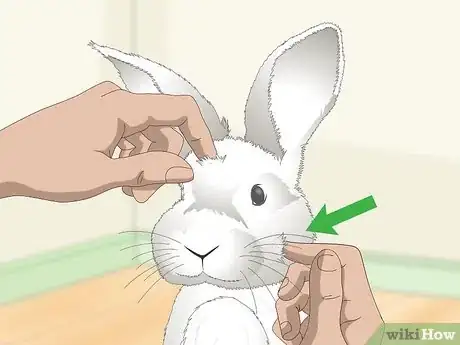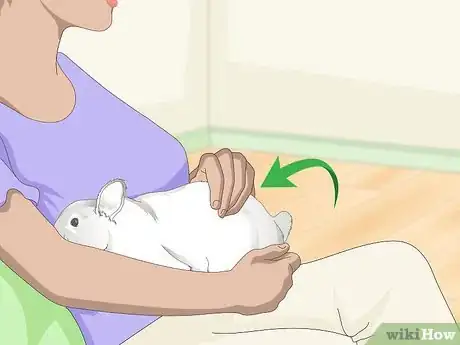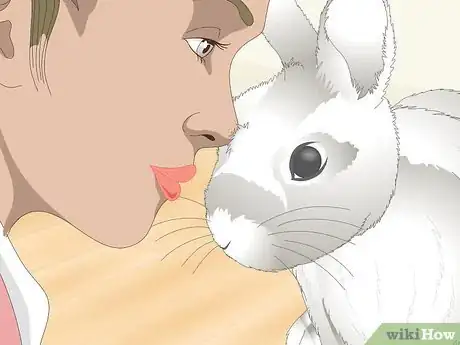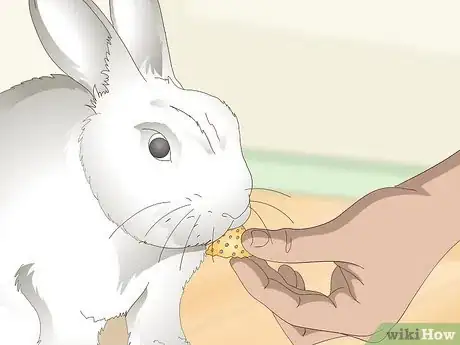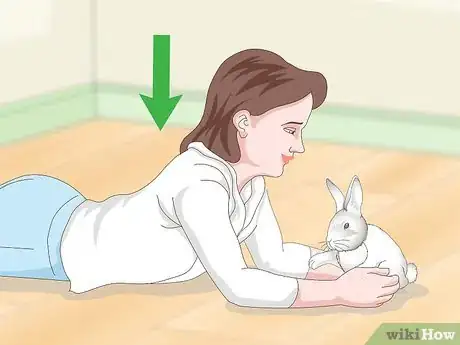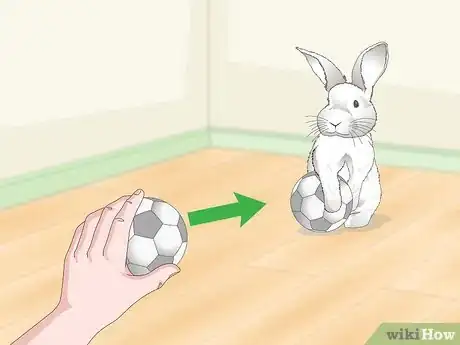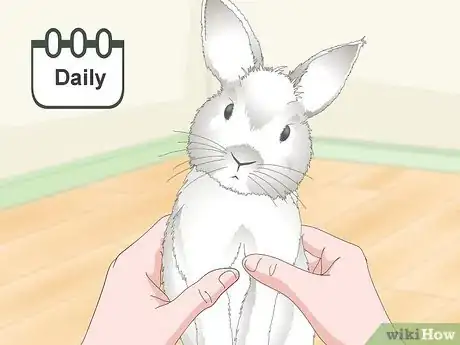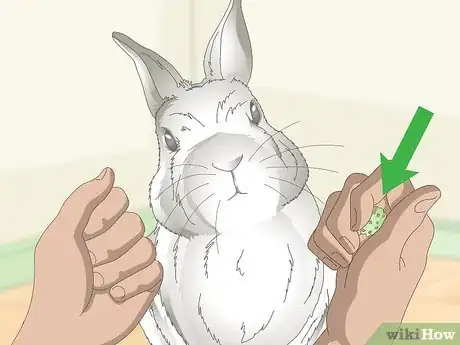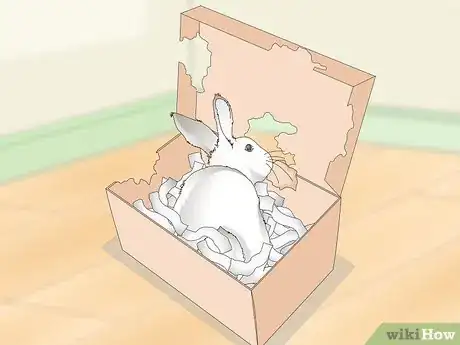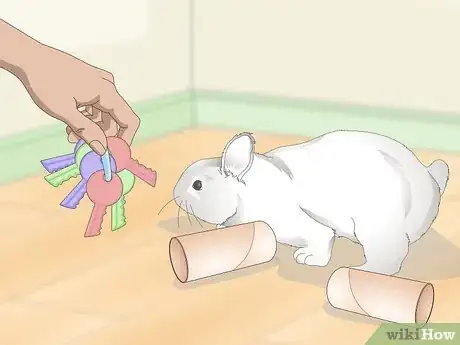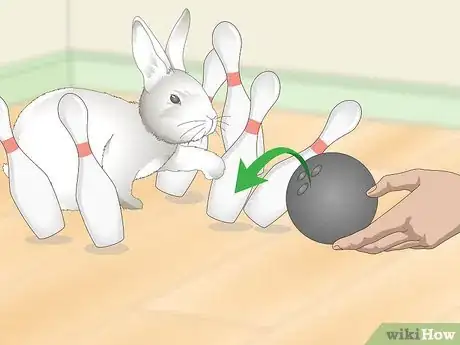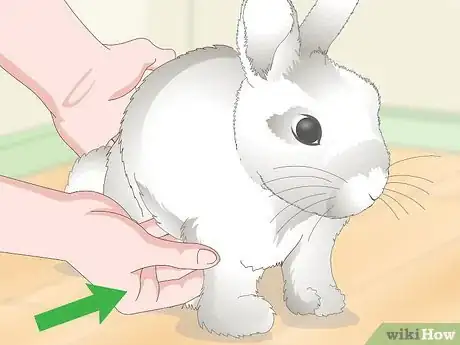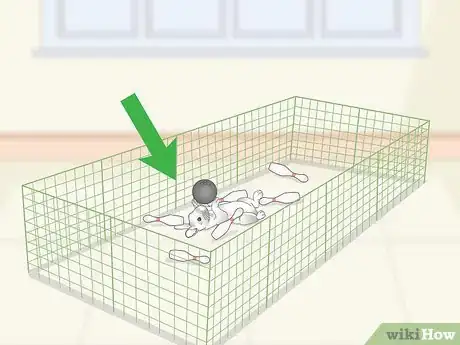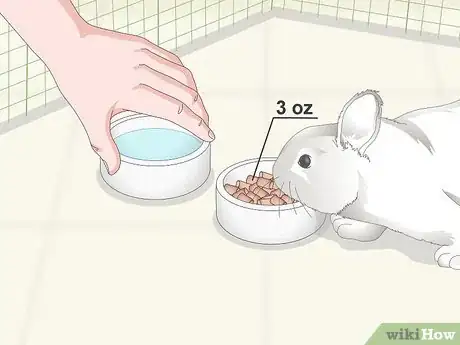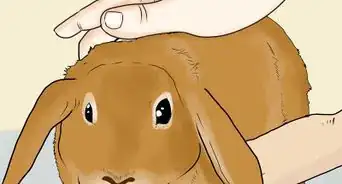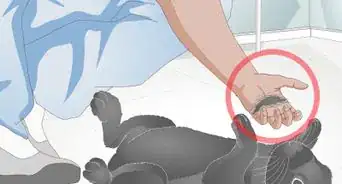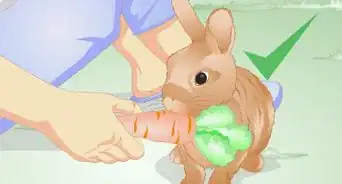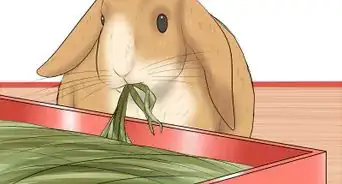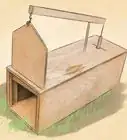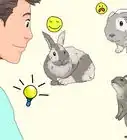This article was co-authored by Pippa Elliott, MRCVS. Dr. Elliott, BVMS, MRCVS is a veterinarian with over 30 years of experience in veterinary surgery and companion animal practice. She graduated from the University of Glasgow in 1987 with a degree in veterinary medicine and surgery. She has worked at the same animal clinic in her hometown for over 20 years.
This article has been viewed 55,620 times.
When you get a rabbit, caring for it and bonding with it are often the first things you learn to do. After this, it's easy to get comfortable and start going through the motions. But loving your rabbit—a combination of affection, communication, play, and handling—meets your rabbit’s behavioral and physical needs and can help you bond with it in a long-lasting way.
Steps
Petting Your Rabbit
-
1Pet your rabbit on the cheeks and forehead. Most rabbits love being pet on these spots. They often put their head to the ground with their eyes closed when they enjoy it. In most cases, they're most receptive to being pet after they've just eaten.[1]
- Avoid touching your rabbits on the neck, ears, stomach, feet, and tail.
- Don’t approach your rabbit from directly overhead or else it will think you’re a threat.
-
2Stroke your rabbit's back as it cuddles with you. While laying down, let your rabbit come close and press its side to your arm. In this position, gently stroke its back to show it affection. Just make sure that your rabbit is facing you so it doesn't see your hand, which some find threatening.[2]
- If your rabbit gets scared when you try to pet it, don't worry—stop and try again when it's more comfortable with you.
- Remember that rabbits are prey animals and some will never enjoy being cuddled even after getting to know you. Don't force it! Some like being cuddled, others will just sit in your lap, and for others being in the same room with you is the most they will do.
Advertisement -
3Nuzzle your nose to your rabbit's face. As you lay on the ground or sit on the bed with your rabbit, rub your nose to its nose. This is a great alternative to stroking its back if it doesn't let your hand come close to it.[3]
- Only put your face close to your rabbit if you’re confident that the rabbit is friendly. The rabbit could try to bite you.
- Remember that most rabbits find faces less threatening than hands. If your rabbit is jumpy, try the nuzzle!
- Hum soft and low as you nuzzle your rabbit's nose.
-
4Feed your rabbit small treats as you pet it. For rabbits, eating is a social activity that helps build trust. When you're sitting with your rabbit and showing it affection, give it some of its favorite treats.[4]
- Most rabbits appreciate apples, herbs, carrots, and oats. Other options are beet greens, asparagus, radish, bok choy, broccoli, parsley, watercress, brussels sprouts, and wheat grass.
- Purchase rabbit treat mixes from the pet store for a nice variety.
Interacting with Your Rabbit
-
1Put yourself on your rabbit's level. Remember that most of the time your rabbit is out exploring, all it sees are legs and feet. To show your rabbit love, get down onto its level! Either lie down or sit on the floor and you'll find it much easier to connect with them.[5]
- Bring your rabbit onto your bed or sofa in situations where you don't want to get on the floor. Make sure to supervise your rabbit at all times so they don’t jump off and get hurt.
- Lie down on your stomach in an area where you bunny plays and let it come to you.
-
2Understand your rabbit's personality type. Like people, rabbits have unique personalities. Some are hyperactive with big personalities, while others are more relaxed and easygoing. Always keep your rabbit's personality type in mind when expressing your love and adjust your behavior accordingly.[6]
- If your rabbit is energetic, play with it as much as you can.
- For rabbits that are more relaxed and calm, cuddle with it and don't make any sudden, quick movements.
-
3Pretend to be a rabbit as you interact with yours. Watch the way rabbits interact with each other and take note. When you get close and show your rabbit love and affection, do the things they do to each other, such as nuzzling noses and throwing toys around the room.[7]
- Don't yell at your rabbit if it bites you! Instead, push it away gently. Remember that you're interacting with your rabbit in the same way as it does with other rabbits, so a bit of nipping is expected.
-
4Interact with your rabbit daily so it doesn't get lonely. Regardless of how you decide to bond with your rabbit and what activities it enjoys most, be sure to interact with it daily. Rabbits are social creatures that require attention and affection every day to stay healthy.[8]
- If you find you don't have lots of time for your rabbit, try interacting with it in short, 5-minute intervals throughout the day whenever you can.
Playing with Your Rabbit
-
1Hide a treat in your hand for your rabbit to find. Give your rabbit mental stimulation with logic games. Start by putting a treat in one of your hands and close it loosely. Now, make a fist with your other hand and hold both in front of you to let your rabbit choose. Give it the treat if it chooses right. If not, start the game over and keep going until it gets it![9]
- Purchase logic toys from an animal store for alternatives.
-
2Give your rabbit something to destroy. A great way to do this is by filling a small shoebox with some shredded paper and letting your rabbit have fun. You can also give your rabbit a phonebook, newspaper, or straw mat to chew up—just make sure you don't need it![10]
- Provide your rabbit with a cardboard box to both hide in and chew on.
-
3Buy some toys for your rabbit to throw. Lots of rabbits like to throw things and play fetch. If your rabbit likes to throw things, give it some baby toys, such as a plastic key set, small blocks of wood, willow balls, knotted jute ropes, and toilet paper tubes.[11]
- Play a game of fetch with your rabbit using any of the toys mentioned above.
-
4Bowl with your bunny. Rabbits love to knock things over and bowling is a great way to let them indulge their mischievous side. Purchase a small plastic bowling set and set them up for your bunny to knock over. You can also stuff empty oatmeal cans or toilet paper tubes with treats or hay to make things interesting![12]
- Praise your rabbit after they knock down the bowling pins or toilet paper tubes.
Handling and Caring for Your Rabbit
-
1Scoop your rabbit under the rib cage whenever you pick it up. Showing love and affection to your rabbit is great, but the wrong form can hurt it. When you pick it up, always place one under its rib cage and the other under its bottom to protect its backbone.[13]
- Always keep your rabbit's kicking legs away from your face. If you don't, it might kick or scratch you by accident!
- Wear a thick shirt to avoid getting scratched by your rabbit's nails.
- Never pick up a rabbit by the ears or scruff.
- Rabbits might act afraid and struggle when you try to pick them up. Try picking them up in a large towel and covering the rabbit’s eyes so it feels calmer.
-
2House your rabbit in a puppy pen or empty room. Although pet stores sell cages that some people put their rabbits in, this isn't a great way to show your rabbit love and affection. Not only that, these tiny cages can lead to many health problems, such as deformities and obesity. A puppy pen is a great choice—you can buy one at a pet store—as is a room that you can dedicate to housing your bunny.[14]
- Let your rabbit explore in an enclosed area outside so it can roam naturally.
- Remember that rabbits are social, curious, and smart. Even though a cage might seem convenient, it will harm your rabbit in the long run.
- Give your rabbit at least 8 square feet (0.74 m2) of housing and an exercise space of at least 24 square feet (2.2 m2).
- If you have to use a cage, make sure it gets at least 3 to 4 hours of time outside the cage daily.
- Try harness training your rabbit so you can take it outdoors on a nice day. This can help your rabbit get vitamin D.
-
3Feed your rabbit 3 ounces (85 g) of pellets daily with clean water. No matter how much affection you give your rabbit, it can't make up for a lack of food and water. Always provide it with its daily food and make sure it has ample clean water. You can also give it a handful of hay or 1 cabbage or lettuce leaf every couple of days.[15]
- Make sure to feed your rabbit during the evening, as they usually eat at night.
- Feed your rabbit 1 type of fresh vegetable at a time to avoid giving them diarrhea.
Warnings
- Wash your hands before and after handling your rabbit.⧼thumbs_response⧽
References
- ↑ http://www.bio.miami.edu/hare/shybun.html
- ↑ http://www.bio.miami.edu/hare/shybun.html
- ↑ http://www.bio.miami.edu/hare/shybun.html
- ↑ https://rabbit.org/bonding-with-your-rabbit/
- ↑ https://rabbit.org/bonding-with-your-rabbit/
- ↑ https://rabbit.org/bonding-with-your-rabbit/
- ↑ https://rabbit.org/bonding-with-your-rabbit/
- ↑ https://rabbit.org/bonding-with-your-rabbit/
- ↑ https://www.thecapecoop.com/how-to-play-with-your-rabbit/
- ↑ https://www.thecapecoop.com/how-to-play-with-your-rabbit/
- ↑ https://www.thecapecoop.com/how-to-play-with-your-rabbit/
- ↑ https://www.thecapecoop.com/how-to-play-with-your-rabbit/
- ↑ http://www.indianahrs.org/rabbit-care/rabbits-as-pets.aspx
- ↑ https://www.thedodo.com/things-to-know-getting-rabbit-1340963451.html
- ↑ https://www.motherearthnews.com/homesteading-and-livestock/raising-rabbits-zmaz75mazgoe
